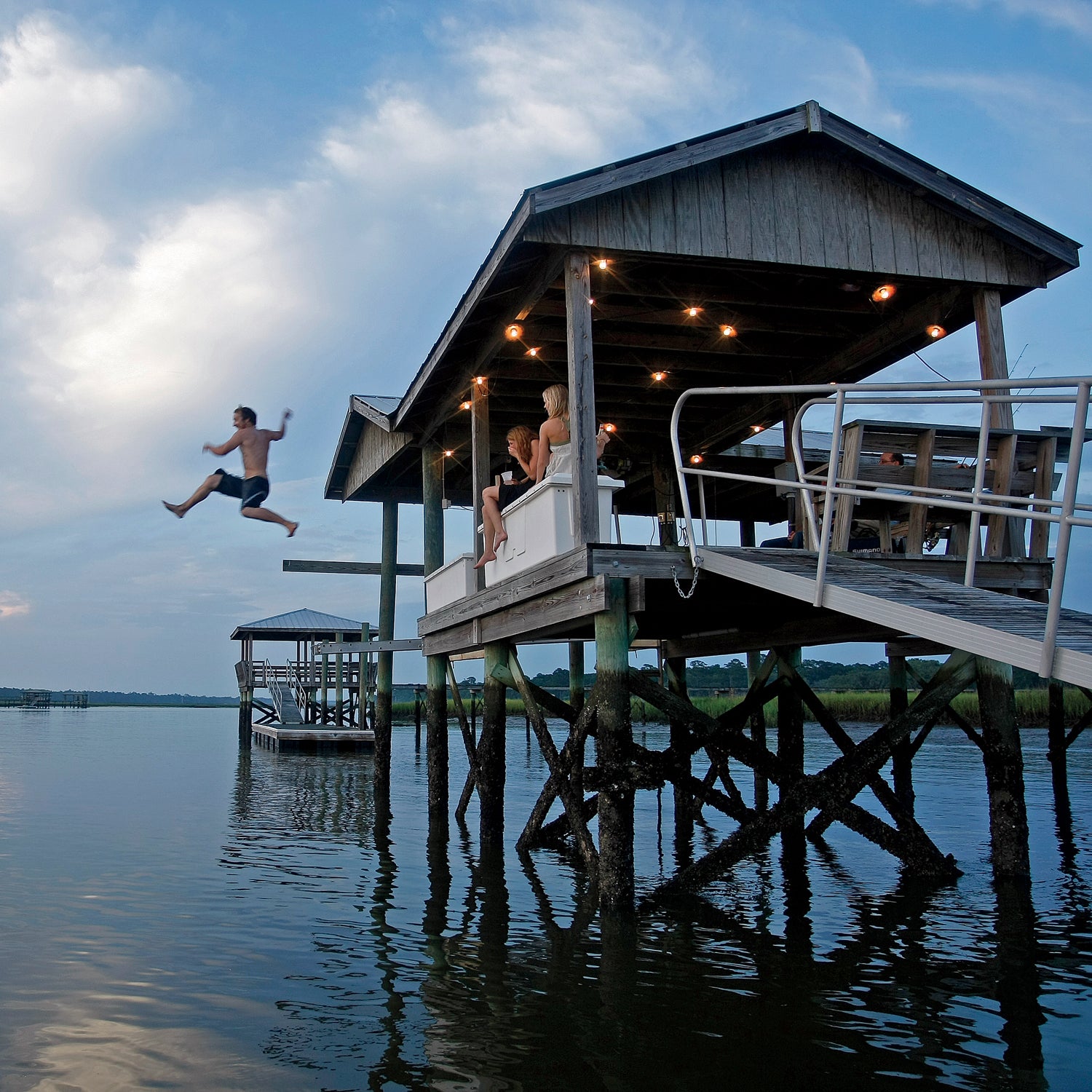These towns are the finest places you’d ever want to call home, from a Midwestern mountain-biking hub, to a Seattle-area hang-gliding mecca, to, um, Boulder. (We know, shocker.)
But don’t just take our word for it. We asked readers to pick their ultimate dream town, a perfect base camp that offers everything from epic singletrack to progressive city planning. They did—21,975 voted in all—and we couldn’t believe their choice. So we dispatched all-knowing travel sage Chuck Thompson to the hills of Tennessee to fact-check our Facebook-sourced, democratically proclaimed Best Town Ever.
Sweet Home…Chattanooga?
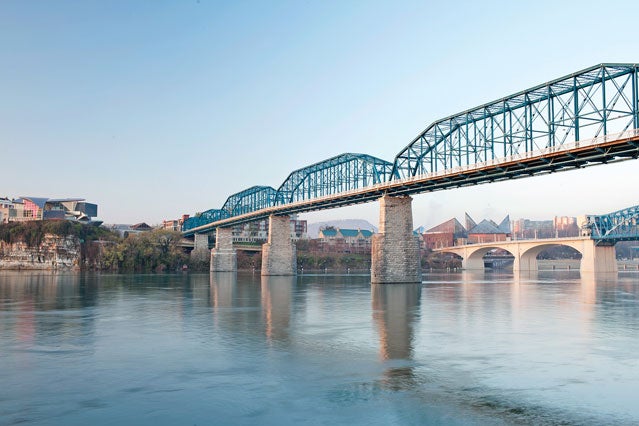
Population: 167,674
Median Age: 37
Median Annual Salary: $23,622
Median Home Value: $128,000
Total Votes: 7,434 (33.8%)
“Chiggers, poison ivy, rednecks, humid summers, cold winters. If you don’t like those things, you shouldn’t come here.”
You wouldn’t know it by listening to him, but Trevor Childress is the best spokesman there is for Chattanooga. You also wouldn’t know that the blond, blue-eyed, 29-year-old Georgia transplant is at the spear tip of a civic and outdoor renaissance that has elevated this city of 167,674 from what comedian Doug Stanhope once callously described as a place “so behind the times that you can’t even get AIDS there yet” to what ���ϳԹ���‘s Facebook voters overwhelmingly dubbed the Best Town Ever.
Officially, Childress isn’t buying the recognition. Consider, however, that in addition to being a professional outdoor guide, he’s also a dedicated rock climber and licensed pilot who happens to be airing his gripes on the shores of a favorite swimming hole after a tour of some of the most wildly textured sandstone climbing crags in the country. Spend much time with Childress and you begin to sense an ulterior motive behind the griping.
“I don’t like ���ϳԹ��� coming in here and naming this the best town ever,” he says, like a kid upset that his secret hideout has been revealed. “I sure didn’t vote for Chattanooga on that thing.”
Plenty of others did. Which is how this river city near the meeting point of Tennessee, Georgia, and Alabama beat out perennial “most livable,” “coolest,” and “Bro, you gotta try this seasonal IPA” meccas like Boulder, Colorado; Burlington, Vermont; and Portland, Oregon.
The explanation for Chattanooga’s sudden jump to civic stardom begins with the literal rise of the Cumberland Plateau. Taking in more than 24,000 square miles on its mountainous run from Kentucky to Alabama, the plateau splinters near Chattanooga to form a labyrinth of jagged ridges and sheer gorges. At the site of Chattanooga itself, the plateau towers more than 1,000 feet above the Tennessee River. The back side of the Cumberland forms the eastern wall of the Sequatchie Valley, a rich hub of recreation whose vertical cliffs and green, flat valley floor long ago established it as the hang-gliding capital of the East.
I get my first gulp of the local adrenaline while attached to Childress on a tandem hang-glide that starts with a leap off a sheer 1,800-foot cliff at a place called Henson’s Gap. On a day with crazy thermal lifts, Childress once pulled off a 53-mile flight from here all the way to Fort Payne, Alabama. Our circle tour over the forest and farmlands below is much briefer but exhilarating enough.
Closer to ground, there are literally hundreds of challenging crags along the plateau. My favorite is a boulder garden, Stone Fort, about 20 miles outside the city, where a staggering playground of big rocks awaits barely two minutes from the car. And, OK, it’s one o’clock on a hot summer weekday—cooler October temps bring out the climbing masses—but Childress and I have the place to ourselves.
During a different adventure, at a place called Raccoon Mountain, I experience the painful pleasure of having my ass handed to me on a rumble-tumble 18-mile network of bike trails. The tight, intermediate-to-advanced singletrack is stuffed with enough sudden rock drops and trees around which to wrap a handlebar that my catalog of hardwood-forest obscenities gets as much of a workout as my legs and arms.
Cavers and creekers are similarly blessed with an abundance of options. Commercial rafts pile up like theme-park bumper boats on the Ocoee River, but you certainly don’t have to join them: within 30 minutes of downtown, there are roughly 30 creeks that feature Class IV or V runs, making Chattanooga a magnet for skilled paddlers.
Still, for people like me who are comfortable with reusable-cloth shopping bags, it’s not easy twisting your head around the idea of ���ϳԹ���‘s Best Town being in a place with a history of monstrous industrial abuse (in the 1960s and 1970s, manufacturing waste and smog made Chattanooga one of the most polluted cities in the U.S.), ubiquitous evangelical dogma, and a reputation for red-state conservatism.
The people of Chattanooga, of course, will tell you that it’s not that simple.
“Chattanooga is an island of sanity in the middle of a very socially conservative place,” explains Minya James, a 30-year-old Chattanoogan who recently started a wooden-boat-building business. “On a social level, I don’t want to say I have a love-hate relationship with the town, because I don’t hate it. I don’t love it, either. But for outdoor recreation, there’s nothing like it.”
Like virtually everyone else I meet during the three days I spend in town, James is a transplant—and most of the others tell the same story. Chattanooga is affordable: the median home value is around $128,000. Major employers such as the Tennessee Valley Authority, BlueCross BlueShield of Tennessee, Cigna, Volkswagen, and McKee Foods (they make all your Little Debbie snacks) provide the foundation of an unflashy yet relatively stable and diverse local economy.
The foodies are coming, too, bringing with them those hipster Portland and Burlington restaurants that emphasize locally grown everything. And even if the hookup scene is lacking—one local single morosely informed me that Chattanooga is “a town of sixes, and barely enough of those”—there are signs of life. The weekend I was in town, the Crash Pad—a new, self-described “boutique hostel” aimed at the outdoor crowd—threw a well-attended party with DJ talent imported from Los Angeles.
As for the town’s political conservatism, I’m reminded several times by locals that it doesn’t always follow the script. Chattanooga’s revitalized waterfront district and the city-operated adventure outfitter Outdoor Chattanooga were green projects pushed through in the early 2000s by then-mayor and current Tennessee Republican senator Bob Corker, a local hero.
Besides, the best cities are sometimes the ones that haven’t quite arrived. They are places where people talk more about momentum and the future and promises yet to be fulfilled than about skyrocketing home values and what a bitch it is to park downtown.
Which is not to say that Chattanooga doesn’t have enough problems to keep the gawking hordes at bay. One man, for certain, is still clinging to them.
“Ticks, mosquitoes, fleas, can’t get a decent job,” Childress moans, continuing to lay out the pitiable string of maladies afflicting his beloved town.
“That’s all part of it—that’s Chattanooga,” Childress says. “I just want everyone to know before they start coming here that that’s what to expect.” Then he relents and almost smiles as a razor-fine shaft of afternoon sunlight cuts toward his favorite swimming hole, hidden at the bottom of a deep, rocky gorge.
“It’s perfect for me, though,” he says, before diving in again.
—Chuck Thompson
Boulder, Colorado
The City Everyone Loves to Love/Hate
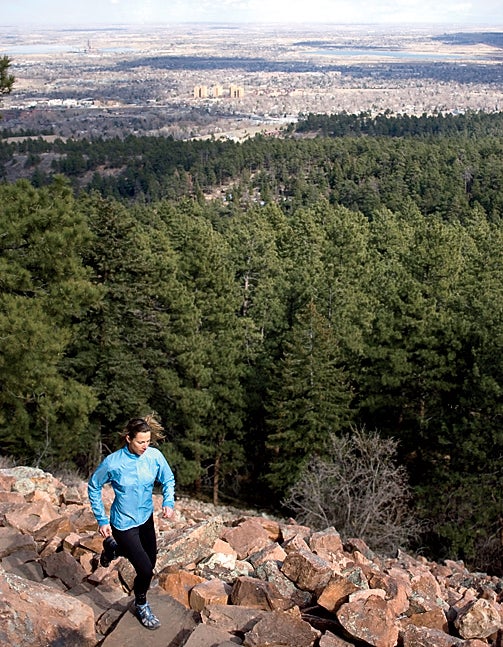
Population: 97,385
Median Age: 28
Median Annual Salary: $47,967
Median Home Value: $477,700
Votes: 1,701 (7.7%)
Yeah, yeah, we’ve had it with Boulder too. America’s perennial fittest, happiest, healthiest, brainiest, VO2-maxiest, most educated, least stressed-out, without-a-doubt-better-than-your-burg town. The annoying truth: if you’re an outdoor-sports fanatic, it’s still a damn nice place to live—climbing and trail running out the back door, easy access to the Front Range, cosmopolitan trappings, collegiate verve, and a tribe of endurance freaks that could field its own Olympic squad. Sure, the real estate prices are on par with Monaco’s, and the People’s Republic is considered a cliché by other Coloradans (prairie dogs are a protected species there, after all). But with a populace that recognizes the city’s outdoor ascendancy and is still dedicated to making it better—in June, Boulder opened Valmont Bike Park, 40 acres of jumps, drops, and racing tracks—it’s hard not to give the town its due.
Staying Power: In 1967, locals passed a new sales tax in order to bankroll an open-space program, the first in the nation to be municipally funded. Today, the net result is more than 43,000 acres of green areas that help keep sprawl at a minimum. In addition, Boulder’s educated populace (it has the most bachelor’s and post-graduate degrees per capita in the nation) lures tech firms and startups that add high-paying jobs to the local economy, making the prices for those turn-of-the-century Victorians not as onerous as they may seem.
Playgrounds: Eldorado Canyon, just south of town, is a classic go-to for climbers, and cyclists can find empty pavement in all of the half-dozen canyons to the west. Skiers need to head farther afield, but nearly all of the classic I-70 resorts, like Copper Mountain and Vail, are within a two-hour drive.
The Voters Speak: “Twenty-seven square miles surrounded by reality, where hippies drive BMWs.” “Live music scene includes local bands String Cheese Incident, Elephant Revival, and Leftover Salmon.” “Filled with health Nazis, but as a jumping-off point for the Rockies, it’s feakin’ awesome.”
—Ryan Krogh
Charleston, South Carolina
Southern Belle, Big-City Charm
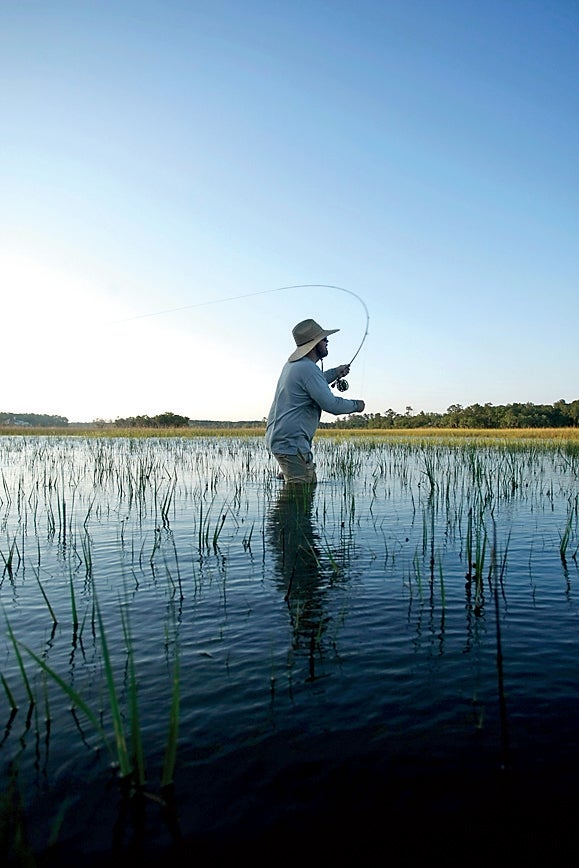
Population: 120,083
Median Age: 32
Median Annual Salary: $47,942
Median Home Value: $477,700
Votes: 2,251 (10.2%)
Yes, Charleston is the Old South. There are horse-drawn carriages, cobbled streets, and the historic City Market, which now sells knickknacks to Yankee tourists. But there’s also more than 90 miles of pristine coastline to surf, kiteboard, sportfish, and sail alongside the likes of local triathlete Tom Mather. The food and history are serious—you can see Fort Sumter and Fort Moultrie from Charleston’s downtown shoreline (known as the Battery), and three consecutive James Beard Foundation Best Chef Awards were bestowed upon the chefs operating restaurants within the city. Locals are active and fit: the Cooper River Bridge Run is one of the most popular 10K races in the country, with 42,000 participants, and bikers and runners swarm the U.S.’s second-longest cable-stay bridge year-round.
Staying Power: Businesses are increasingly owned by guys like Mike Ray, the proprietor of Normandy Farms Bakery, who won a buckle biking the Leadville 100, swam around Key West, and completed the Coeur d’Alene, Idaho, Ironman this June. Thanks to the College of Charleston, as well as local blue chips Boeing and Bosch—not to mention a healthy tourism industry—Charleston’s economy will keep humming along.
Playgrounds: Folly Beach is known for football-playing frat boys, but you’re just as likely to see wind-surfing hippies. Biking through the French Quarter and the Battery under massive live oaks is a popular pastime, but kayaking through the marshes to Bowens Island is gaining steam. Otherwise, join the Citadel boys, who run around 60-acre Hampton Park. Just don’t talk smack about the South.
The Voters Speak: “Ninety miles of coastline, barrier islands begging for exploration, and tidal creeks perfect for a sunrise paddle.” “The ladies!” “Annual events like Charleston Fashion Week, Charleston Wine and Food Festival, and Spoleto add to the progressive culture.” “Full of sweet tea and good manners.”
—Charles Bethea
Santa Fe, New Mexico
No Country for Old Ideas
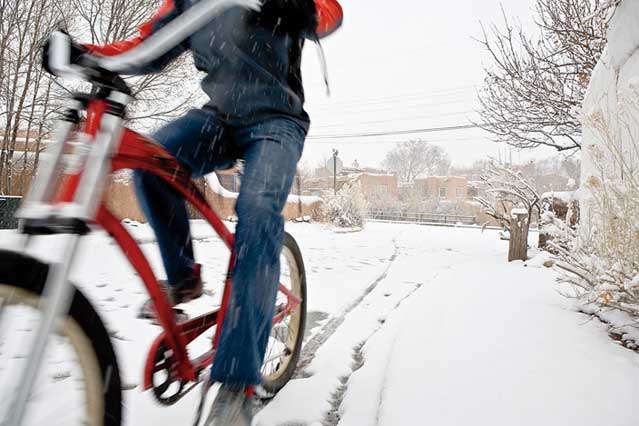
Population: 67,947
Median Age: 41
Median Annual Salary: $52,045
Median Home Value: $306,400
Votes: 585 (2.7%)
Adobe buildings and art galleries are as abundant as Texas tourists paying too much for turquoise. And, yes, tourist dollars, along with the film industry (No Country for Old Men, The Avengers), are two of the biggest moneymakers in town. That’s a good thing. No major industrial presence means the second-cleanest skies in the nation, and the out-of-state dollars help support New York City—caliber restaurants and the venerable Santa Fe Opera. For locals, there’s also a vibrant farmers’ market and probably more natural foods per capita than anywhere. And because it’s situated in the high desert of northern New Mexico, the City Different is also a sportsman’s paradise—Colorado-style mountains without the crowds.
Staying Power: Santa Fe, which celebrated its 400th anniversary last fall, maintains that old Southwest character—donkey-cart-wide streets and red-chile ristras—but it’s also taken a progressive approach to the future. In 2006, it was the first city in the nation to accept the 2030 Challenge, a call to make all municipal buildings carbon-neutral by 2030. Last summer the city installed a hydroelectric plant downstream of its water-treatment facility, meaning that municipal water runs through energy-generating turbines on its way to household taps—the only such system in the country.
Playgrounds: The Dale Ball Trails, five minutes away in the foothills of the Sangre de Cristo Mountains, are a classic for after-work romps, and by year’s end the city will add 3.4 miles of trails to the La Tierra multi-use system just north of town. Forty-five minutes away, the subalpine valleys and low peaks of the Jemez Mountains, even despite this year’s fires, remain a popular destination for hikers, climbers, and, in winter, cross-country skiers. North, the famous steeps of Taos Ski Valley beckon.
The Voters Speak: “Easy access to tons of trails—Dale Ball, La Tierra, Atalaya—within 15 minutes of home.” “A world-class opera, marvelous vistas, and clear blue skies.” “Has more great restaurants and art galleries per capita than any city in the U.S.”
—Will Grant
Madison, Wisconsin
Not Just the Best of the Rest
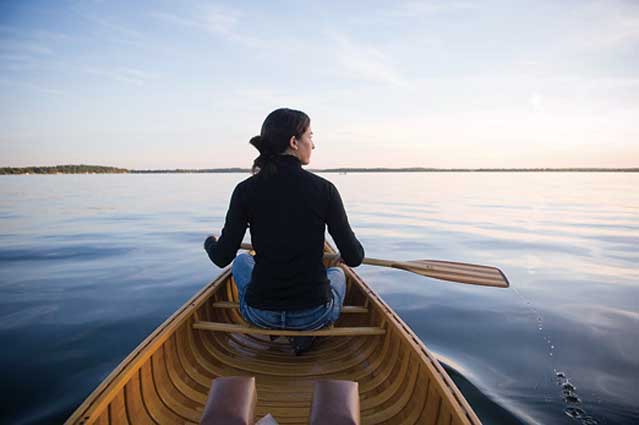
Population: 233,209
Median Age: 31
Median Annual Salary: $49,595
Median Home Value: $220,200
Votes: 750 (3.4%)
It may seem like Madison is the token Midwest selection on every best-of list simply for not being another glorified grain elevator. But Madtown is as outdoorsy as any Rocky Mountain Oasis. Paddling and road cycling are particular passions, the latter thanks to Pacific Cycle, Planet Bike, and the Trek Bicycle Store, all headquartered in this area. Sustainability is the city’s other passion: eco-saints John Muir and Aldo Leopold developed their ideas here, and Madison is a leader in localism, with more than 50 community-supported farms and the country’s largest weekly farmer’s market. Plus, almost every weekend you can find a free block party, concert, marathon, or beer festival—like the Great Taste of the Midwest, which serves more than 500 types of brew every August.
Staying Power: The city’s highly educated, fiery citizens (see the political protests earlier this year) keep politicians focused on the long view, something the city has done since 1911, when it commissioned a parks-heavy urban-planning road map based on the idea that recreation “contributes to a physical and moral health.” A century later, Madison still has ambition, including a detailed plan to become the bike-commuting capitol of the U.S. by adding bike boulevards, bike stoplights, even a two-wheels-only café.
Playgrounds: The city is flanked to the west by the Driftless Area, a forested region of rolling hills, bluffs, and streams where trout fishermen and roadies spend hours getting happily lost. Hikers hit up the Capital City, Military Ridge, and Glacial Drumlin trails. Come winter, the city grooms 25 miles of paths in local parks to create a cross-country wonderland.
The Voters Speak: “One of the few places you can bike, paddle, or ski to work.” “Plays host to the Ironman, Madison Marathon, Paddle and Portage, and Canoecopia.” “Four-season awesomeness.”
—Jason Daley
Ashland, Oregon
Size Matters
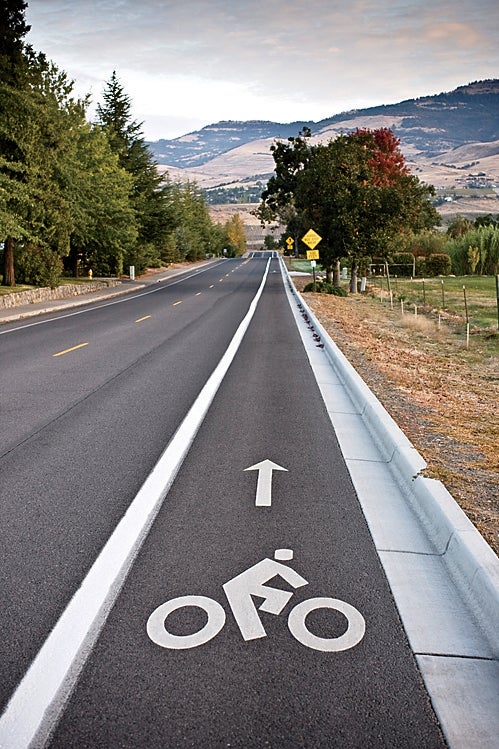
�ʴDZ�ܱ����پ��Dz�:��20,078
Median Age:��43
Median Annual Salary:��$38,436
Median Home Value:��$393,300
TOTAL Votes:��1,154 (5.3%)
It isn’t for a lack of Californians hoping to move in that Ashland has managed to stay small. There just isn’t room. Penned in between the Cascade and Siskiyou ranges in the south end of the Rogue Valley, this Golden State border city has clung to its Northwest roots through sheer, stunning geography. Home prices are hefty, but residents rarely travel more than an hour to find clean rivers, lonely trails, or expert skiing. The 88 Napa-style wineries downvalley have attracted yuppies but also culinary variety in the form of 80 restaurants offering everything from sushi to seven variations of French cuisine. One of them, Chateaulin, is a favorite after-performance spot for actors from the city’s renowned Shakespeare festival.
Staying Power:��In 1973, the town passed a law forcing cars to share Main Street with bikes. Thirty years ago, residents voted yes to a no-big-box-store ordinance. And last year they increased the lodging tax by 2 percent to support cultural happenings like the Ashland Independent Film Festival, one of 20 annual events that range from a chocolate fest to mountain-bike races. Growth has been hampered by the recession, but smart startups like Dagoba Organic Chocolate, the bike-mechanic college United Bicycle Institute, and even a smattering of software and tech firms have helped increase job prospects.
Playgrounds:��Lift access to Mount Ashland’s 45-degree slopes is 20 miles south of town, mountain bikers and runners connect to the 2,600-mile Pacific Crest trail from a dozen in-town trailheads, and road bikers can easily get lost on the back roads in wine country. For paddlers and fly-fishermen, the Klamath, the Rogue, and the Illinois rivers are an easy drive away.
The Voters Speak:��“The entire town is walkable.” “Which do you prefer: life at 100 miles per hour or 100 smiles per hour?” “Where else can you catch a beautiful rainbow trout by day, then catch a Shakespeare play by night?”
—Kyle Dickman
Portland, Maine
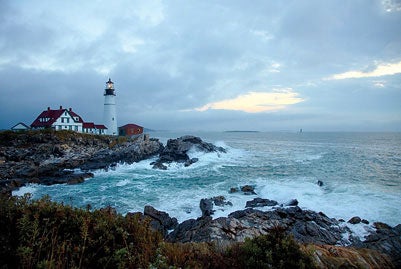
Salty Dog
�ʴDZ�ܱ����پ��Dz�:��66,194
Median Age:��36
Median Annual Salary:��$37,438
Median Home Value:��$249,700
TOTAL Votes:��704 (3.2%)
In a centuries-old fishing town two hours north of Boston, gentrification was bound to happen. But on the way to the refurbished warehouses and arty boutiques, Portland managed to preserve its locavore ethos, which is rooted in a 243-year-old farmers’ market. Now the gastronome scene is as good as the saltwater access. Urban farmers set up shop in East Bayside, growing organic produce and fermenting mead year-round, and lobstermen and fishermen keep the harbor in the Old Port’s waterfront district bustling. But there’s more than just food here: there are paddle-friendly shores on Casco Bay and hurricane-induced surf on the Atlantic beaches, while two hours away lie the long trails of New Hampshire’s White Mountains. Real estate is affordable, and there are jobs to be had: Portland is the state’s commerce capital, and L.L.Bean’s corporate headquarters are 20 minutes up the road.
Staying Power:��In 2006, Portland launched a robust sustainability plan that included a 30-mile expansion of its waterfront trails, a buy-local campaign that helped stabilize the economy, and a tax-funded program to expand and restore public art. Downtown there are half a dozen microbreweries, including Allagash and Shipyard, and 38 restaurants that keep the brick warehouses filled with energy.
�ʱ����ⲵ���dzܲԻ��:��There are nearly as many kayakers as lobstermen plying the waters of Casco Bay, and whitewater paddlers can journey north to the Class IV-V Penobscot and Kennebec rivers. Cape Elizabeth is only a 30-mile road ride from Portland, and in winter, two of the East Coast’s best ski resorts are within a three-hour drive—Sunday River and Sugarloaf.
The Voters Speak:��“One of the only places on earth where you can ski at 8 a.m., surf at 1 p.m., and eat a five-star dinner at 7 p.m.” “Small-city charm—no traffic or trouble getting to the woods or the ocean—but with the culture of a big city.” “Lobster!”
—Alicia Carr Troxell
Burlington, Vermont
Champlain Toasts
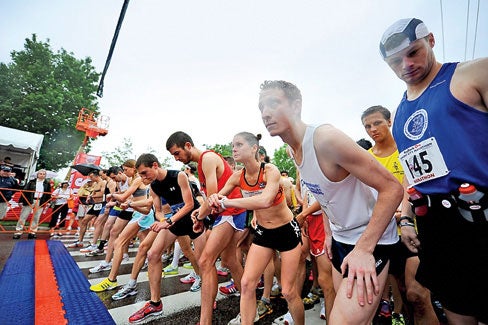
�ʴDZ�ܱ����پ��Dz�:��42,417
Median Age:��27
Median Annual Salary:��$38,598
Median Home Value:��$249,900
Votes:��786 (3.6%)
Stop us if this sounds familiar: a college town anchored by a left-leaning university, with enough bars in a four-block radius to slake the thirst of an army of frat boys and a pedestrian-only main drag full of crepe vendors, retail outlets, locally sourced restaurants, bike racks, and street performers. We thought so. But what sets Burlington apart from other U-towns is its affordability and, more important, its Green Mountain State sensibility. What’s that mean? Smart grassroots organizations like the alt-transportation group Local Motion; great local food and beer like the pizza at Flatbread American, Farmhouse Tap and Grill, and (of course) Ben and Jerry’s. And there’s one really, really big lake.
Staying Power:��Burlington’s waterfront has been revitalized in the past two decades as the city cleaned up derelict industrial sites to make way for parks, restaurants, a seven-mile rail-to-trail bike path, and the city’s Community Sailing Center. The recession took a toll on Vermont’s economy, but Burlington businesses, such as Web developer Dealer.com and Green Mountain Roasters, continue to expand. On the food front, there’s an innovative cooperative that allows citizens to own a stake in a 350-acre farm outside of town.
Playgrounds:��Thirty minutes from downtown, you’ll find a backcountry ski paradise in Bolton Valley, with its famous Bolton-Trapps trail. The rolling roads outside the city are perfect for cycling, while Stowe, home to one of the eastern United States’ best ski resorts and a growing network of mountain-bike trails, is only 45 minutes away. Then there’s Lake Champlain and the city’s sailing center, the perfect place to base your catamaran, canoe, or sea kayak and launch for the 30-minute paddle north to Lone Rock Point.
The Voters Speak:��“Halvorson’s Upstreet Cafe on Church Street, still one of the best places to grab a beer and a burger after a day outside.” “I love the fact that people cross-country ski to work after a big snowfall.” “Brew pubs, boating, biking, blue skies, Ben and Jerry’s. It ain’t B-Town for nothing.”
—Abe Streep
Portland, Oregon
If It Ain’t Broke…
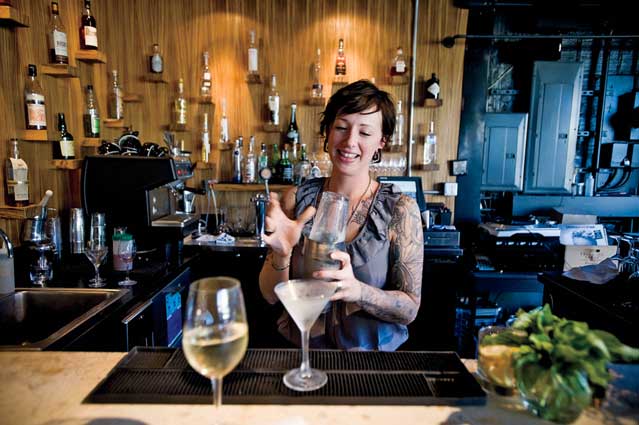
�ʴDZ�ܱ����پ��Dz�:��583,776
Median Age:��36
Median Annual Salary:��$50,203
Median Home Value:��$296,100
�մdzٱ��:��685 (3.1%)
A long time ago in a city far, far awry, men reveled in preposterous mustaches, women brandished victory gardens of armpit hair, and the citizenry took an unyielding position against an urban plan that, like so many across the country, would have run a freeway roughshod over a host of lush, peaceful old neighborhoods. This was Portland back in 1974, a sublime tableau of mountains, rivers, rainforest, and ocean serving as backdrop to these courageous stands.
Staying Power:��Today, local hair fashions may look like the revenge of ’74, but Portland itself has evolved. That crucial defeat of some wannabe Robert Moses snowballed, slowly transforming the city into a paragon of alternative transportation, its transit dollars funneled toward infrastructure projects like the ever-expanding MAX light-rail system, biodiesel buses, streetcars, an aerial tram, a suburb-serving commuter rail, and a 330-mile bike-route network set to double in size by 2030. The neighborhoods work more like Old World villages, the parks are plentiful (more than 300), and the streets are incredibly friendly to pedestrians and cyclists. Economy-wise, Portland was recently recognized by��Kiplinger’s��as a comeback city for its growth in the software and clean-tech industries, adding gobs of jobs in what has been a tough market. Rain (and more rain) or shine, this place is hard to beat.
�ʱ����ⲵ���dzܲԻ��:��The Pacific Northwest is like a little New Zealand. Looming behind downtown are the squat, verdant Tualatin Mountains, home to 5,100-acre Forest Park. Throw in nearby Mount Hood, with its year-round snowsports, and the Willamette and Columbia rivers, and you start to get the idea.
The Voters Speak:��“The Columbia Gorge, Mount St. Helens, Mount Adams, the Cascades, the Coast Range, Smith Rock—all within a few hours’ drive from downtown.” “Great beer, coffee, and food carts everywhere.” “Ski powder in the morning, sleep on the beach that night!”
—Jeremy Spencer
Tucson, Arizona
The Hottest Playground
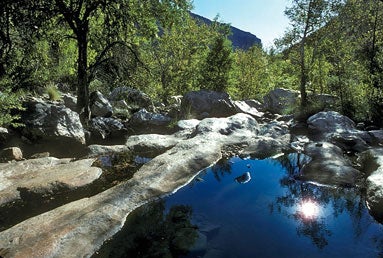
Population: 520,116
Median Age: 33
Median Annual Salary: $35,565
Median Home Value: $162,400
Votes: 5,925 (27%)
The Grand Canyon State largely deserves its reputation as a place of unchecked sprawl and snowbird escapism. Tucson works hard to be the exception. Growing organically out of the Sonoran Desert, it’s by far the most forward-thinking community in the state, thanks largely to the University of Arizona. In 2010, mayor Bob Walkup declared his town the Winter Training Capital of America, and he wasn’t full of hot air: flanked by five mountain ranges, Tucson is prime workout ground for pro cycling teams and triathletes. Providing the pulse is a young population that betrays Arizona’s retiree stereotype: the clubs, restaurants, and vintage shops along Fourth Avenue are a slice of Greenwich Village, and because the Old Pueblo is eminently affordable, it’s long been home to a strong community of artists, writers, chefs, and environmentalists. The burritos? You could eat a different one every day of the year.
Staying Power: Last year, Tucson decided that its 700 miles of bike lanes weren’t being used effectively, so it’s now transforming 170 miles of slower streets into mixed-use bike boulevards to encourage cycling. And with a healthy tech sector anchored by defense contractor Raytheon, the university, and an accelerating number of solar and clean-tech startups, employment has held steady throughout the recession.
Playgrounds: Starting on the city’s northeast boundary, the road ride up Mount Lemmon goes from 2,500 feet to 9,000 in 26 miles—with the country’s southernmost ski resort at the top and 5.6-5.13 crags along the way. Sabino Canyon, in the northern foothills, has 235 miles of rolling, saguaro-studded running trails, and 30 minutes south of the city is Madera Canyon, offering some of the best birding in the country.
��
The Voters Speak: “Mountain views, big night skies, and lightning during the monsoons.” “El Charro: margaritas and carne seca burritos.” “You don’t have to shovel sunshine!”
—Will Palmer
Next Big Things
Flagstaff, Arizona:��It’s almost too perfect: college town (pop. 65,800), ponderosa-scented air, situated below the 12,600-foot San Francisco Peaks. That combination means mornings in the mountains (winter skiing, summer biking or running), afternoons rock climbing (at famous Paradise Forks), and evenings casting for pike at Upper Lake Mary. But locals are happy staying right in town, too, where the 50-mile Flagstaff Urban Trail System is used by 78 percent of the populace and altitude-training marathoners sip local brews at the Pay ‘N Take. At 7,000 feet and with 100 inches of snow annually, Flagstaff is no desert, and all that fun is no mirage.��—Will Palmer
Ithaca, New York:��Facing off from opposing hills above downtown, Ithaca College and Cornell University are geographic high points (pop. 30,000), but they serve as cultural underpinnings as well. From on high, the endless adventure possibilities are also apparent: canoeing and kayaking in Cayuga Lake (or cycling around it), running on the 558-mile Finger Lakes Trail, or hiking to one of the 150 waterfalls within a ten-mile radius. The liberal leanings are better described as far-left pacifism, but where else can you find the manpower to create the world’s largest human peace sign (5,000 Ithacans, circa 2008)?��—Alicia Carr Troxell
Traverse City, Michigan:��Northern Michigan’s nickname, God’s Country, may be a slight exaggeration. But not by much. The area includes million-acre Huron-Manistee National Forest (hiking, mountain biking), the 22-mile-long Old Mission Peninsula (kayaking, cycling), and hundreds of miles of Blue Ribbon trout streams. But it’s also full of depressed towns with restaurants that offer kill-and-cook specials. Traverse City (pop. 14,300) is the exception. Its acclaimed film festival (founded by rabble-rousing documentarist Michael Moore), a national writers’ series, and the nearby Interlochen Center for the Arts provide plenty of culture. The city’s 150-store downtown and five microbreweries take care of the commerce.��—Jonah Ogles
Wilmington, North Carolina:��Similar to Charleston: southern charm, a 300-year-old harbor, ample seafood. But what sets Wilmington (pop. 106,500) apart from its genteel South Carolina neighbor is an economy in overdrive—not long ago, it was the second-fastest-growing economy in the U.S. Thanks to EUE Screen Gems, it’s also home to the largest motion-picture and television studio outside California. (The local film industry employs some 800 people.) Situated where the Cape Fear River meets the Atlantic, the former military port’s recreation options are mostly water-based—sea-kayaking, sailing, deap-sea fishing—and the biggest party of the year is, naturally, Riverfest, a frenzy of vendors, fireworks, music, athletic competitions, and invading pirates.��—Whitney Dreier
Durango, Colorado:��Think of it as a border town. It has Southwest underpinnings—Mesa Verde National Park is only 47 miles to the west—but because it sits in the lush Animas River Valley, it serves as the geographic and cultural link between high desert and high country. A thousand miles of mountain-biking trails surround the city (pop. 16,900), the largest wilderness area in Colorado is just to the north (500,000-acre Weminuche Wilderness), two ski resorts are an easy drive away, and the paddle-friendly Animas flows almost down Main Street. At night, four local craft breweries appease the nearly 4,000 students at Fort Lewis College.��—Will Grant
Missoula, Montana:��At first glance, Missoula might strike you as just another sports-obsessed burg like Boulder. Which is not untrue: there are no fewer than three dozen cycling, paddling, skiing, and fly-fishing shops inside city limits (pop. 66,800). But the former lumber town is in close enough contact with its industrial past to have retained its old grit. The University of Montana has outsize influence, adding intellectual vibrancy the city might lack otherwise. At local institution Charlie B’s, you can catch a glimpse of what Missoula used to be, lumberjacks and Forest Service employees, doing their best to crowd out today’s ubiquitous species: college girls in GO GRIZ T-shirts.��—Ryan Krogh
Chico, California:��By California standards, this former mining camp is in the middle of nowhere. Which is why it’s so great. Ninety miles north of Sacramento, Chico (pop. 86,000) is hidden between two national forests and serves as the de facto gateway for NorCal’s outdoor playgrounds—Mount Shasta, Lassen Volcanic National Park, and Lake Tahoe are all within a three-hour drive. And the city itself has spirit. Anchored by California State University at Chico, it has a collegiate vibe and progressive city policies, like a 2007 law requiring new developments to design bike-friendly features. It’s also home to the Sierra Nevada Brewing Co., cofounded by CSU alum Ken Grossman, and one of the largest municipal green spaces in the country, Bidwell Park.��—Michael Webster
Hardwick, Vermont:��No town holds Vermont’s locavore credentials quite so dear as Hardwick, a small (pop. 3,200) former granite-mining town northeast of Burlington. Starting a few years back, the place basically reinvented itself as one large co-op, with vibrant community-agriculture programs, a year-round farmers’ market (no small accomplishment in northern Vermont), and a program that rents kitchen space to local food producers. It also serves as the gateway to the wild, woolly Northeast Kingdom: from downtown, you’re just 20 minutes from skiing in Stowe, fly-fishing near Johnson, and mountain biking in East Burke.��—Abe Streep
Issaquah, Washington:��As Boeing’s and Microsoft’s fastest-growing bedroom community, the former lumber town (pop. 23,200) has experienced a surge in out-of-towners in the past few years. And for good reason: a 20-minute drive can put you in downtown Seattle or the oyster flats on Puget Sound. An hour away, there’s skiing in the Cascades, kayaking and rafting on the Class IV Skykomish River, and access to a half-dozen steelhead streams. Even better, Issaquah hasn’t been totally yuppified. The biggest party of the year is Salmon Days, a two-day festival in October celebrating the return of the spawning fish.��—Kyle Dickman
How You Picked Them
To select ���ϳԹ���‘s Best Town Ever—Chattanooga, Tennessee—we scoured our archives and pulled together the hundreds of great cities that have made the cut over the years, narrowing the list to ten that still had it all: culture, jobs, reasonable home prices, stress-free living, and proximity to the outdoors. Then we opened it up to you. All ten squared off on our , where 21,975 of you voted for your favorite. Competition was fierce; Chattanooga nabbed it through a combination of votes and enthusiastic reader submissions. And because many of the finalists presented in these pages are no secret (we’re looking at you, Boulder), we decided to highlight some next-big-thing alternatives, too.

